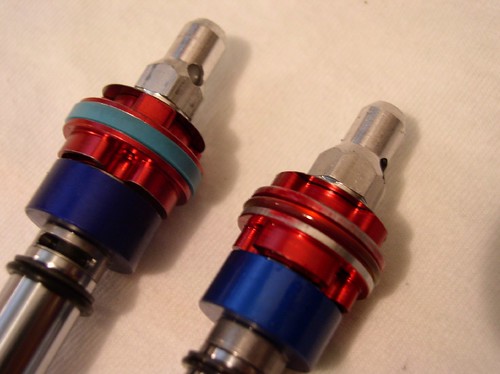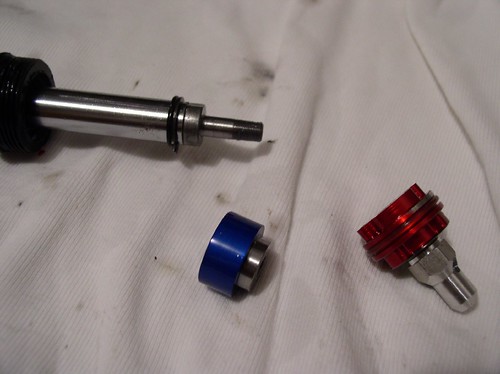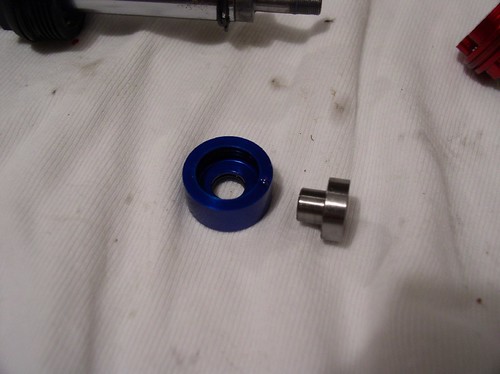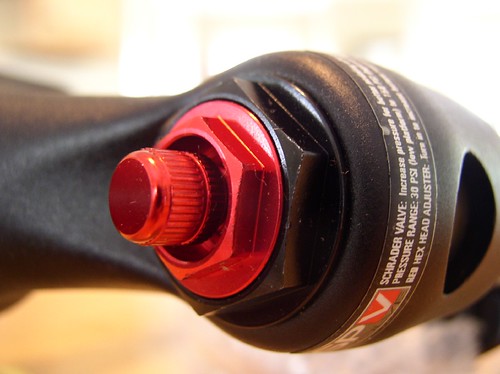crash n' burn
Likes Bikes
Tips and tricks for tuning your manitou fork
There isn't a huge amount of info in those Manitou service guides, so i've found this pretty helpful..
Tips and tricks for tuning your Manitou fork

I’ve always been a fan of Manitou forks because I find them easy to maintain and they have lots of ‘tweakability’. This post looks at some of the routine maintenance that you should perform on your fork and offers some ideas for tuning some of the Manitou forks out there. Most of the information here is applicable to 2004 and 2005 forks with TPC and SPV damping.
Note: Make sure that you read the manual that came with your fork. If you’re unsure about what to do, bring it to someone who can perform the tasks for you. It should go without saying that you should verify with the manufacturer whether or not performing any modifications will void your warranty.
Maintenance
With any fork it is a good idea that you learn how to properly maintain it. It is amazing how many people have never opened up their fork to perform routine maintenance. Forks take a lot of punishment and especially if you live anywhere where it gets wet, gritty, or dusty, you need to maintain them if you want them to last.
Manitou forks have always been really easy to maintain. Early models used Micro Lube ports for grease injection. Newer models utilize a semi-bath lubrication between the outer legs and the stanchions. Working with semi-bath is easy but it is messy so you need to make sure you have plenty of rags and drip pans around before you open up your fork.
But before you bust open you fork, do yourself a big favor and read the manuals. First download the Service Guide for your particular year and model fork from here.
These guides provide the instructions for maintenance. They are pretty good, however the best information online is located at the Enduro Fork Seals web page. These guys have pictorial instructions for many forks which also includes basic maintenance steps. I want to shout out a huge thanks for all the work they have done as it is amazing!
Note: I think you can convert older Micro-lube Manitou forks to semi-bath forks using these Enduro Seals.
Between the service guide and the pictorial instructions at Enduro Fork Seals you have more than enough ammunition to perform some basic maintenance. I’m just going to highlight a couple of points and offer some tips.
There are several fluids used for basic maintenance on Manitou forks:

The 8mm screw located in the bottom of the right leg is actually the bottom of the damper shaft. It is screwing into the bottom of the outer leg, so in order to take the leg off you have to screw the damper shaft IN. Clockwise. This is really counter intuitive.
The bolt on the left side is removed just like a regular screw: counter clockwise.
Other notes on working with your fork:
Go slow. When you put the semi-bath oil into the legs and you go to push the legs all the way back on, put a rag over the open holes in the bottom of the legs. And push the legs back on slowly. I shot synthetic motor oil halfway across the garage onto my wife’s new car one time.
Add some air. When rethreading the damper shaft back into the outer legs, and putting back the bolt on the left side leg, it helps to have some air in both the right and left sides.
Watch out for the air pressure. If the fork is turned upside down, don’t press the air valve. Why? Because there is oil in there and it is under pressure… Flush eyes with cold water if this happens to you. Not that I did this or anything!

Mangling the damper shaft o-ring. There is a rubber o-ring on the bottom of the damper shaft. This o-ring can get mangled when screwing the damper shaft back into the outer legs. A small amount of semi-bath can leak out if this o-ring’s shape is compromised. Some guys on mtbr say that you can find replacement o-rings at the hardware store or use RTV silicone to help seal it.
Many Manitou forks are air/coil springs. The coil is located inside the left leg of your fork. Manitou uses a lot of grease to lube up the coil and compression rod that is inside this leg. They didn’t do a good job of sealing this side so over time the grease will seep down into the insides of the outer leg. When you take off the outer legs instead of having light semi-bath oil drip out, you might find a thick sludge where the grease has congealed with the semi bath. This is usually an issue on a fork that has been sitting on the shelf for a long time. You can clean out the heavy grease, and lube it more lightly. This will minimize the problem however you should check the condition of the grease when you maintain the fork.
Careful when reinstalling the SPV damper shaft. When replacing the SPV damper shaft back into the inside of the right leg, be really careful. Grease the wiper and screw it in as if you were threading a screw. It is easy to mangle the wiper on the interior threads of the inner leg.
Use a proper size socket. You can take off the top caps with a crescent wrench but it is probably a good idea to get the proper size socket. Some Nixons may require a special socket through Manitou. See this thread at mtbr.
Tuning tips for your Manitou fork
Air/coil spring. A lot of the 04/05 forks are Air/Coil springs. The first part of the travel is taken up with the coil spring. These springs are available for your specific body weight — red is medium, blue is soft. You can play around with different combinations of air pressure and coil weights and the trick is to get a good transition between the two. If you have too much air and the spring is too soft, you will create a transition in the overall spring rate, usually around mid stroke.
TPC damping. I had a TPC damped Black 100. It was a super cushy fork, which was fine for downhilling, but I felt for cross country it robbed too much power under pedaling. The TPC lockout damper is mounted in the top of the fork leg offers some compression damping adjustment but not much. The remote lockout on my fork offered no compression damping at all. One way that can add some more compression damping to your fork is to add more oil on top of the air spring in the top of the left leg. As the fork compresses it will have less air volume in this chamber and will stiffen up some.
The forks take 5wt oil. You can try to run a heavier weight oil to affect the compression damping, however be aware that this will also affect your rebound damping.
SPV damping. Stable Platform Valve damping is one of Manitou’s core damping technologies. SPV allows riders to set up a ‘platform’, or firm setting that limits ’spiking’ on the way up and down. Technologies like these are always a tradeoff between small bump compliance and pedaling effeciency. It’s kind of one of those love it or hate it things, but I like it from an XC perspective. I find that there’s a lot of adjustability with the SPV system but it can be hard to zero in on the best setting, so take notes and be patient.
If your fork is an older model, the original SPV damper had some issues with it:

Note: Answer changed the damper in 2005 from the SPV damper to the SPV Evolve damper. The one on the left is the ‘05 Evolve the right one is the ‘04.
The Evolve damper has a teflon wiper and uses a newer grease that is doesn’t break down in fork oil. In addition, they drilled a small hole in the check valve. So there is always some oil that flows in the circuit which softens the transition.
There isn't a huge amount of info in those Manitou service guides, so i've found this pretty helpful..
Tips and tricks for tuning your Manitou fork

I’ve always been a fan of Manitou forks because I find them easy to maintain and they have lots of ‘tweakability’. This post looks at some of the routine maintenance that you should perform on your fork and offers some ideas for tuning some of the Manitou forks out there. Most of the information here is applicable to 2004 and 2005 forks with TPC and SPV damping.
Note: Make sure that you read the manual that came with your fork. If you’re unsure about what to do, bring it to someone who can perform the tasks for you. It should go without saying that you should verify with the manufacturer whether or not performing any modifications will void your warranty.
Maintenance
With any fork it is a good idea that you learn how to properly maintain it. It is amazing how many people have never opened up their fork to perform routine maintenance. Forks take a lot of punishment and especially if you live anywhere where it gets wet, gritty, or dusty, you need to maintain them if you want them to last.
Manitou forks have always been really easy to maintain. Early models used Micro Lube ports for grease injection. Newer models utilize a semi-bath lubrication between the outer legs and the stanchions. Working with semi-bath is easy but it is messy so you need to make sure you have plenty of rags and drip pans around before you open up your fork.
But before you bust open you fork, do yourself a big favor and read the manuals. First download the Service Guide for your particular year and model fork from here.
These guides provide the instructions for maintenance. They are pretty good, however the best information online is located at the Enduro Fork Seals web page. These guys have pictorial instructions for many forks which also includes basic maintenance steps. I want to shout out a huge thanks for all the work they have done as it is amazing!
Note: I think you can convert older Micro-lube Manitou forks to semi-bath forks using these Enduro Seals.
Between the service guide and the pictorial instructions at Enduro Fork Seals you have more than enough ammunition to perform some basic maintenance. I’m just going to highlight a couple of points and offer some tips.
There are several fluids used for basic maintenance on Manitou forks:
- Synthetic Motor Oil is used for the semi-bath lubrication.
- Regular Motor oil is used for the 3cc that goes over the air piston.
- 5wt Fork Oil is used for placing inside the right leg.

The 8mm screw located in the bottom of the right leg is actually the bottom of the damper shaft. It is screwing into the bottom of the outer leg, so in order to take the leg off you have to screw the damper shaft IN. Clockwise. This is really counter intuitive.
The bolt on the left side is removed just like a regular screw: counter clockwise.
Other notes on working with your fork:
Go slow. When you put the semi-bath oil into the legs and you go to push the legs all the way back on, put a rag over the open holes in the bottom of the legs. And push the legs back on slowly. I shot synthetic motor oil halfway across the garage onto my wife’s new car one time.
Add some air. When rethreading the damper shaft back into the outer legs, and putting back the bolt on the left side leg, it helps to have some air in both the right and left sides.
Watch out for the air pressure. If the fork is turned upside down, don’t press the air valve. Why? Because there is oil in there and it is under pressure… Flush eyes with cold water if this happens to you. Not that I did this or anything!

Mangling the damper shaft o-ring. There is a rubber o-ring on the bottom of the damper shaft. This o-ring can get mangled when screwing the damper shaft back into the outer legs. A small amount of semi-bath can leak out if this o-ring’s shape is compromised. Some guys on mtbr say that you can find replacement o-rings at the hardware store or use RTV silicone to help seal it.
Many Manitou forks are air/coil springs. The coil is located inside the left leg of your fork. Manitou uses a lot of grease to lube up the coil and compression rod that is inside this leg. They didn’t do a good job of sealing this side so over time the grease will seep down into the insides of the outer leg. When you take off the outer legs instead of having light semi-bath oil drip out, you might find a thick sludge where the grease has congealed with the semi bath. This is usually an issue on a fork that has been sitting on the shelf for a long time. You can clean out the heavy grease, and lube it more lightly. This will minimize the problem however you should check the condition of the grease when you maintain the fork.
Careful when reinstalling the SPV damper shaft. When replacing the SPV damper shaft back into the inside of the right leg, be really careful. Grease the wiper and screw it in as if you were threading a screw. It is easy to mangle the wiper on the interior threads of the inner leg.
Use a proper size socket. You can take off the top caps with a crescent wrench but it is probably a good idea to get the proper size socket. Some Nixons may require a special socket through Manitou. See this thread at mtbr.
Tuning tips for your Manitou fork
Air/coil spring. A lot of the 04/05 forks are Air/Coil springs. The first part of the travel is taken up with the coil spring. These springs are available for your specific body weight — red is medium, blue is soft. You can play around with different combinations of air pressure and coil weights and the trick is to get a good transition between the two. If you have too much air and the spring is too soft, you will create a transition in the overall spring rate, usually around mid stroke.
TPC damping. I had a TPC damped Black 100. It was a super cushy fork, which was fine for downhilling, but I felt for cross country it robbed too much power under pedaling. The TPC lockout damper is mounted in the top of the fork leg offers some compression damping adjustment but not much. The remote lockout on my fork offered no compression damping at all. One way that can add some more compression damping to your fork is to add more oil on top of the air spring in the top of the left leg. As the fork compresses it will have less air volume in this chamber and will stiffen up some.
The forks take 5wt oil. You can try to run a heavier weight oil to affect the compression damping, however be aware that this will also affect your rebound damping.
SPV damping. Stable Platform Valve damping is one of Manitou’s core damping technologies. SPV allows riders to set up a ‘platform’, or firm setting that limits ’spiking’ on the way up and down. Technologies like these are always a tradeoff between small bump compliance and pedaling effeciency. It’s kind of one of those love it or hate it things, but I like it from an XC perspective. I find that there’s a lot of adjustability with the SPV system but it can be hard to zero in on the best setting, so take notes and be patient.
If your fork is an older model, the original SPV damper had some issues with it:
- The valve used a grease that broke down over time in oil which caused the SPV valve to stick.
- The wiper for the damper was an O-ring which caused some stiction.
- There was sort of an on/off type of operation to the check valve which caused a harsh transition between platform and no platform.

Note: Answer changed the damper in 2005 from the SPV damper to the SPV Evolve damper. The one on the left is the ‘05 Evolve the right one is the ‘04.
The Evolve damper has a teflon wiper and uses a newer grease that is doesn’t break down in fork oil. In addition, they drilled a small hole in the check valve. So there is always some oil that flows in the circuit which softens the transition.



